A 40-year-old ‘veteran’ runner has become the first to complete the gruelling Ramsay Round in Lochaber in winter in less than 24 hours.
The route, which can be tackled clockwise or anti-clockwise, involves climbing almost the height of Everest, summiting 24 mountain tops over a 97km (60-mile) course.
The Ramsay Round was first accomplished in 1978 by Charlie Ramsay, who arrived back at his start point at Glen Nevis Youth Hostel with two minutes to spare.
Jon Gay, a Fort William architect did the circuit solo, with just a food station stop half-way round, and broke the existing winter record by a mighty three hours.
He became the 70th person officially to finish the Ramsay Round, and only the fourth known winter completer.
Here, he describes his run, including Britain’s highest mountain Ben Nevis.
I was extremely fortunate to complete a Ramsay’s Round in stunning weather and snow conditions this weekend and finished in a time of 23hrs, 18mins.
Having the advantage that the Ramsay is within running distance of my house it is possible to pick my weather – assume drizzle in Fort William.
This time there was superb winter conditions; very benign.
Paradoxically I believe that the snow surface made significant parts of the run easier than summer.
I like spend most of my spare time in these hills and admit to failing many a winter Tranter or Ramsay attempt over the years.
My brother Dan, who has completed a summer Ramsay and I became experienced at running the Corrour to Tulloch railway after abortive attempts – great for the neck muscles and general awareness.
Last February we managed to get well over half way anti-clockwise before retiring with cold feet.
At the time Andy Kitchin was going the other way and also stopped due to the cold after a similar distance – we saw his head torch at Loch Treig. We realised that if you aggregated the times it proved that the winter round could be done in less than 24 hours, assuming perfect conditions.
I was pleased to complete a Ramsay’s in summer 2010 along with Pete Duggan.
I am an average runner, especially on the flat, but OK at ascending or general hill bashing. Completion for me in winter seemed a long shot.
My friend Bruce Poll who is a ‘Ramsayist’ and aspirant Alpine guide had blogged about the improving climbing and snow conditions during the last week of very settled high pressure.
I asked him if it was runnable up top. He said: “Yes, solid; remember your axe.”
Arguably a wind chill of –20c, frozen to sea level and snow line at 600m would comprise full winter conditions – continental ones possibly.
Axe and crampons were extensively needed. From studying the weather it was obvious that there was zero cause for concern here.
As implied above I am not up to attempting in harsh weather at the winter solstice, but this would be a much more admirable ethic for completion.
This time I decided to go clockwise; not start in the middle of the night, nor walk to the start; nor go unsupported with a huge sack. This strategy had resulted in my latest retreat in January.
Sense prevailed and I asked my friend and fellow Lochaber Athletic member Tark Gunn, at short notice, to provide food and motivational support at Loch Treig Dam
Ascending the Ben the cloud was down and there was fine snow falling. Here we go again, I thought, while struggling with my crampons and reviving my fingers.
But emerging down Carn Mòr Dearg Arête which was runnable due to snow cover, I entered an Alpine wonderland with rime on the rocks and full styrofoam névé underfoot. Extensive snow cover was visible throughout the route.
CMD was way quicker than summer; most of the rubble was banked out. Descent was a full but careful run. Even a man in heavy plastic boots was fairly shifting. Initially I thought he might be doing a Ramsay.
The ascent of the west face of Aonach Mòr was a little hairy in places, in Kahtoola flexible 10-point
walking crampons, with pockets of water ice and very hard névé.
On top, some ski mountaineers asked me if I was OK and had I lost something? Why would anyone be running about up there?
Fortunately the descent of the narrow Coire a’Bhuic, possibly the technical ‘crux’ of the route went well. I had tried digging an improvised snow inspection pit but could hardly penetrate the snow with the axe, it looked very safe.
I carefully climbed along the back of the broken cornice and front pointed down the steep to a more comfortable angle.
I have traversed the Grey Corries many times but never has the ‘running track’ been this amenable; the hard snow covered nearly all the rubble.
I had to phone Tark to say I was early. Just before meeting my upstairs neighbour I was able to sprint down to Stob Ban, although I nearly emasculated myself with my crampons in an unfortunate slide, didn’t know my knee bent that far.
The following describes the next few hills and are trends throughout the route: firm snow down to near valley level. Not once did my foot go through crust; the surface was reliable.
There was no ploughing through heavy snow. In some popular areas preserved footprints enabled crampons to be avoided, saving time. There was water ice in the valley. Much of the heather was covered.
My split of about nine hours at Chno Dearg, say half-way, illustrates the strength of the conditions.
I witnessed stunning orange Alpenglow as the sun set when I was descending this hill at twice the speed of heather bashing. An Alpine day.
Along the track after Corrour innate mediocrity kicked in and I slowed.
I met a guy called Viv who was completing a fast Loch Treig round – I realised that we had seen him at the dam. I had thought his footprints might have been from a Ramsayist. Again this shows how good the mountain running was that day.
At Loch Eilde ruin I saw headtorches. Amazingly they proved to be supporters for Jason Hubert’s anti-clockwise Ramsay’s attempt.
A big coincidence but shows consensus on the quality of the conditions. I was grateful for the coffee and malt loaf they gave me and I had a short rest.
Kinlochleven was rather tempting at the time. I met Jason and friend on Sgùrr Eilde Mòr; this was very uplifting. It looked like he was going well. He warned me that the Mamores were icy. I confirmed that the Grey Corries were a dream.
Shortly after I started feeling sick, weak and dizzy; completely debilitating.
I gave in a number of times and had to lie briefly in the snow, before becoming cold. It was a thorough effort of will to move.
If there had been any weather threat or higher windchill I would have force marched myself immediately down, I guess to the bothy.
But it appeared to be temporary low blood sugar or the body generally protesting as it does on these long routes. Glucose gradually brought me back to life.
Binnein Beag was a grim experience. I felt bad again on Na Gruigaichean where in my tired state the lights of Kinlochleven were tantalising.
The Mamores were indeed icy and I believe retain less snow level than the Grey Corries side.
Therefore the rocks protrude through which slowed things down relative to my earlier mountain ‘pavement’ experience.
The out and back legs are a slog, spiced up with their isolated exposed moves. I have done the Mamores too many times and I can be forgiven for not feeling an appropriate sense of adventure at points, the sickness making a minor reappearance.
Sgùrr a Mhàim’s ascent was soul destroying, especially against the clock. I had haemorrhaged two hours in the Mamores, no doubt from my earlier overexuberance.
Seeing Mullach nan Coirean under the moonlight raised my spirits exponentially and reminded me of our winter 19-hour Tranter’s round when we were nearly dead on our feet.
If I could do it then I could do it now, especially without ice-block feet. I think this is crucial; this time two pairs of wool-lined waterproof socks did the trick.
The descent from Mullach wasn’t the dream I had been expecting and I fell several times on water ice, too tired to care or to put my crampons on again.
Despite having been living for the moment I could stop running – let’s call it jogging by that point. It was almost disappointing to do so; such was my exhilaration at the end.
In conclusion, besides the mountains being so runnable and the weather perfect, the near full moon topped everything.
The solid snow may have made it faster or marginally less exhausting than summer.
I have been extremely lucky. I am obviously delighted to complete but feel humbled to have got a decent time in winter when many runners could have gone faster in such wonderful conditions.
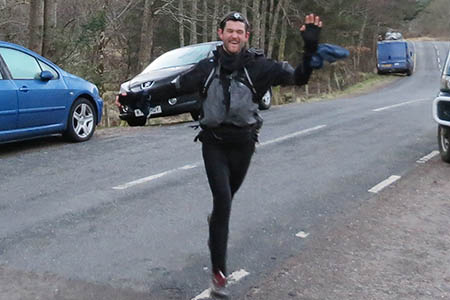
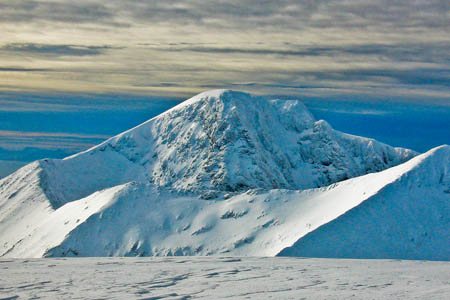
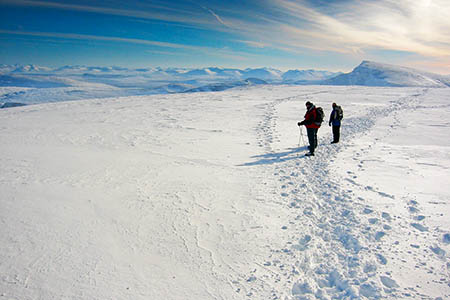
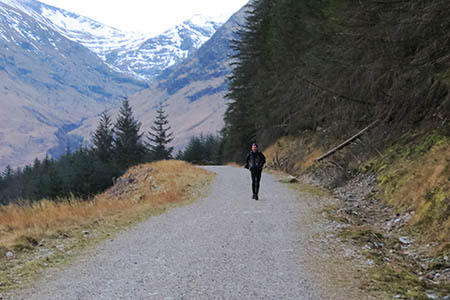
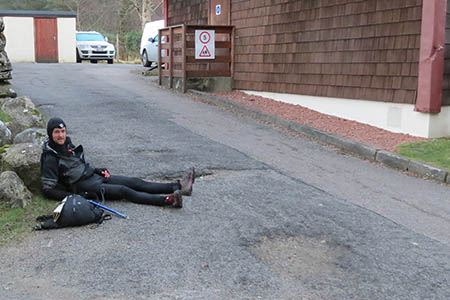
Peter Duggan
01 March 2013Stupendous achievement (surely the most coveted 'first' in Scottish big rounds!), but note that the number of known finishers remains at 69 with Jon now listed twice (at #58 and #70) for his summer and winter rounds.
Peter Duggan
02 March 2013Six complete winter rounds now I'm aware of:
Glyn Jones, 53:34 (November 2002)
Gary Tompsett, 32:48 (March 2003)
John Fleetwood, 47:55 (March 2006)
Shane Ohly, 29:59 (February 2008)
Tom Phillips, 26:57 (December 2012)
Jon Gay, 23:18 (February 2013)
Unless you're only counting December to February (despite John Fleetwood's photos showing true winter conditions)?
See http://www.shr.uk.com/LongDistanceRecords.aspx?LongDistanceRecordID=3 for the improving 'best' times and http://longdistancechallenges.blogspot.co.uk/2006/03/winter-ramsay-5-7-march-2006.html for John Fleetwood's round.